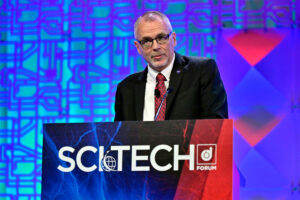NASA Calls for Continuous American ‘Heartbeat’ in LEO
New Strategy for Sustaining U.S. Presence in Low Earth Orbit Announced
By Anne Wainscott-Sargent, AIAA Communications Team

Jim Free, NASA Associate Administrator, delivers remarks Tuesday, January 7, at the 2025 AIAA SciTech Forum in Orlando, Florida. AIAA–©
ORLANDO, Fla. – When NASA retires the International Space Station by the end of 2031, the space agency intends for the United States to not just have capability in microgravity, but to have a continuous “heartbeat” in low Earth orbit, emphasized NASA Associate Administrator Jim Free as he unveiled NASA’s Low Earth Orbit (LEO) Microgravity Strategy during the 2025 AIAA SciTech Forum in Orlando.
The announcement follows last month’s release of NASA’s publication of its final LEO goals and objectives, which inform its long-term strategy to advance microgravity science, technology, and exploration. The framework aims to sustain human presence in orbit, drive economic growth, and strengthen international partnerships.
“A continuous heartbeat is what we have had today [with the ISS] for 24 years – a true, unbroken, continuous presence, where there’s always a person living and working in space,” said Free. “It’s written in US policy. It affects our national posture. Truthfully, if we don’t have continuous heartbeat, we risk not being the partner of choice for our international partners. We risk ceding low Earth orbit to others.”
Speaking to a global gathering of 6,000+ engineers and other technical aerospace leaders from commercial firms, government and academia, Free outlined NASA’s strategy for ensuring this continued presence, even as the agency prepares to support the transition of LEO.
Free, an Ohio native who began his NASA career in 1990 as a propulsion engineer at Goddard Space Flight Center, was inducted as a new AIAA Associate Fellow this year. He discussed the role of the ISS as a “beacon of what humanity can do when we work together.”
“For over 24 years, the ISS has allowed us to partner and continuously live and work off the planet,” said Free. “Its value goes beyond symbolism. It has been a cornerstone of our human space flight program…laying the foundation for everything we’re building toward today.”
To date, the ISS has hosted nearly 4,000 research and educational investigations from over 100 countries.
He cited examples of research on the ISS that has driven better understanding of how the human body reacts to being in space for long time periods as well as biopharma breakthroughs such as protein crystal growth that has improved the formulation of cancer drugs. One investigation with Merck has resulted in better ways to deliver cancer drugs using an injection instead of an IV.
NASA’s LEO strategy remains integral to its broader ambitions for deep space exploration. The microgravity environment in LEO offers a cost-effective, easily accessible proving ground for technologies and research necessary for human missions to explore the solar system.
As part of its LEO sustainment strategy, NASA will award contracts through the agency’s in-space production applications to support commercial development of new and promising technologies for in space manufacturing of advanced materials and products for use on Earth, as well as semiconductor materials and optical fiber production. According to Free, a key need from industry partners is better environmental control and life support systems on spacecraft or habitats.
“With most of the journey to Moon and Mars occurring in microgravity, the objectives give the opportunity to continue vital human research, test future exploration systems, and retain the critical skills needed to operate in the microgravity environment,” stated NASA publicly in late December.
NASA needs the United States to continually operate in LEO as it launches long-duration trips as a warm-up to Mars, and to ensure there are affordable and frequent commercial transport options to support the traffic to and from low Earth orbit. The agency plans to issue a second RFP this June for its Commercial Low Earth Orbit Development Program, designed to support the development of commercially owned and operated LEO destinations from which NASA, along with other customers, can purchase services and stimulate the growth of commercial activities in LEO.
“Our primary need is to mitigate risk for future trips to Mars with long duration flights in LEO of six months to a year. With the time we have left on ISS, we won’t have a statistically significant population of six-to-12-month missions to properly understand the risks of going to and returning from Mars,” he told AIAA SciTech Forum attendees.
The final framework includes 13 goals and 44 objectives across seven key areas: commercial low Earth orbit infrastructure, operations, science, research and technology development for exploration, international cooperation, workforce development and STEM engagement, and, public engagement.
Free said a key component of developing the strategy was weighing input from industry partners, whose feedback has served as “a cornerstone of the strategy.” NASA received 1,800 pieces of input during two workshops hosted in the UK and in Washington, D.C. last year.
“The comments we got were incredibly helpful,” said Free, who indicated the feedback validated the strategy. One piece of input from European space partners was the desire for faster scientific return, and as a result, “we added a new goal and objective around rapid LEO science to help us increase the pace of research.”
The input also led to a new objective for public engagement focused on collaborating NASA’s communication efforts to reach new audiences.
The new LEO strategy supports the United States’ national posture, or global standing as a leader in space.
During the Q&A, Free touched on a variety of topics, including NASA’s commitment to going to the moon, the agency’s digital engineering approach, the most exciting impact of AI on NASA’s work, and advice to AIAA’s technical committees and the new generation of aerospace workers.
He said AIAA remains an invaluable partner to NASA and its technical committee a valuable source of free-flowing discussions and ideas. He urged AIAA members to give feedback on the second draft RFP when it comes out.
“We need the feedback so the Commercial LEO Destinations program can be better,” he said.
Free also reiterated how important it is for the United States to continue to lead in space.
“If you try and think about a world where we do not lead in space – I have not experienced that in my lifetime, and I don’t want to,” he concluded.
Following the presentation, Karen Barker, an AIAA member since 1993, called NASA’s strategy for a sustained presence in LEO “very encouraging.”
“He explained why LEO is so important for us – a pillar on which to build to go other places. It’s extremely important that we keep our heartbeat in LEO,” she said, adding that she was pleased how open NASA is to getting feedback from industry, both on the LEO strategy and the upcoming RFP.
“It’s so important for us as a community to do that,” said Barker, CEO of Alabama-based BRAHE Corporation, a consulting firm that serves defense and aerospace clients.
On Demand Recording Available
# # #
Read NASA’s vision for the next generation of human presence in low Earth orbit and how the agency envisions achieving this future.
Banner Image: four CubeSats in low Earth orbit. | Credit: NASA




